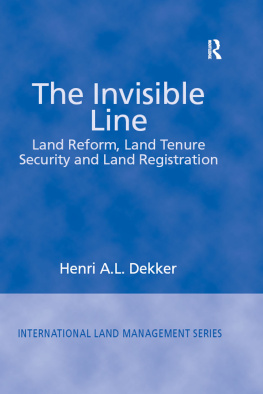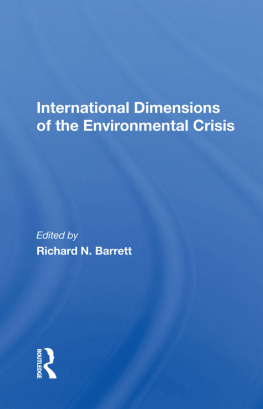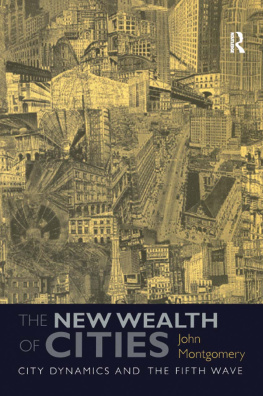
International Dimensions of Land Reform
Also of Interest
Agricultural Sustainability in a Changing World Order, edited by Gordon K. Douglass
Agrarian Reform and Rural Poverty: A Case Study of Peru, Tom Alberts
The Agrarian Structure of Bangladesh: An Impediment to Development, F. Tomasson Jannuzi and James T. Peach
Underdevelopment and Agrarian Structure in Pakistan, Mahmood Hasan Khan
The Emergence of the NIEO Ideology, Craig Murphy
Implementing Rural Development Projects: Nine Critical Problems, edited by Elliott R. Morss and David D. Gow
Transferring Food Production Technology to Developing Nations: Economic and Social Dimensions, edited by Joseph J. Molnar and Howard A. Clonts
Small Farm Development: Understanding and Improving Farming Systems in the Humid Tropics, Richard R. Harwood
Farm Management in Peasant Agriculture, Michael Collinson
Food Security for Developing Nations, edited by Alberto Valds
Plantation Agriculture, Second Revised Edition, P. P. Courtenay
Available in hardcover and paperback.
A Westview Special Study
International Dimensions of Land Reform
edited by John D. Montgomery
Land reform became an international issue in the aftermath of World War II, when the United States planned to dispossess the Junker in Prussia and actually participated in major land redistribution programs in Japan, the Republic of China, and Korea. It became a canon of United States foreign policy in the Philippines, Thailand, and Iran, as well as a centerpiece of Kennedy's Alliance for Progress in Latin America in the 1960s. Gradually U.S. efforts were joined by those of other countries, international organizations, and voluntary agencies.
Although much has been accomplished, the need for land reform is still critical in many parts of the world. But new challenges are being voiced against traditional views of the relevance of land reform to global needs and against the forms international efforts have taken. This book, which appraises both the ethics and experiences of international involvement in land reform, is the first comprehensive review of the international aspects of this important domestic policy.
John D. Montgomery is professor of public administration at the John F. Kennedy School of Government at Harvard University and is the chairman of the Department of Government there. He is the author or editor of numerous books and articles including Technology and Civic Life: Making and Implementing Development Decisions (1974) and Patterns of Policy (1979), He has more than twenty-five years of experience consulting on the organization and management of public activities in the United States and abroad.
International Dimensions of Land Reform
edited by John D. Montgomery
First published 1984 by Westview Press
Published 2018 by Routledge
52 Vanderbilt Avenue, New York, NY 10017
2 Park Square, Milton Park, Abingdon, Oxon OX14 4RN
Routledge is an imprint of the Taylor & Francis Group, an informa business
Copyright 1984 by Lincoln Institute of Land Policy
All rights reserved. No part of this book may be reprinted or reproduced or utilised in any form or by any electronic, mechanical, or other means, now known or hereafter invented, including photocopying and recording, or in any information storage or retrieval system, without permission in writing from the publishers.
Notice: Product or corporate names may be trademarks or registered trademarks, and are used only for identification and explanation without intent to infringe.
Library of Congress Catalog Card Number: 84-50121
ISBN 13: 978-0-367-01648-7 (hbk)
Contents
, John D. Montgomery
, Joseph S. Nye, Jr.
, William C. Thiesenhusen
, R. Albert Berry
, John P. Powelson
, John D. Montgomery
, John W. Harbeson
, John M. Cohen
, John D. Montgomery
The authors of the chapters in this book acknowledge with gratitude the support provided by the Agency for International Development (AID), the Ford Foundation, the Lincoln Institute for Land Policy (LILP), and the Centro Internacional De Mejoramiento De Maiz Y Trigo (CIMMYT). Funds from these sources permitted us to prepare these studies and to review them during an intensive three-day conference in Mexico. In particular, Ms. Joan Atherton of AID went out of her way to provide documentation and to assist the conferees in gaining access to conflicting points of view about land reform experiences in different countries, and Mr. Arlo Woolery of the LILP offered his unfailing good humor and effective leadership as general chairman of the conference. Mr. Robert Havener of CIMMYT demonstrated perfect hospitality and logistical good sense in all of the conference arrangements. To these three individuals and their institutions we are particularly grateful.
J.D.M.
1
Land Reform as an International Issue
John D. Montgomery
Who owns the Earth? Most Atlantic countries regard land as a form of personal property; most of Eastern Europe considers it a collective good. Both groups have tried to export their ideologies of ownership wherever their influence has run, whether by force or conquest, colonial rule, foreign aid, international conferences, or friendly advice. No state has fully lived up to its own ideal in the homeland: all have compromised in practice without ever acknowledging failure in theory. Despite decades of experience and experiment, facts about the consequences of private versus collective ownership are still uncertain. The possibility remains that both of the models are irrelevant to the needs of developing countries. But each persists in an ideal form ready for export and thus as an issue in the international arena.
The issue deeply divides nations. The struggle for land has made revolutions and thus has been a destabilizing force internationally. In the absence of revolution, land possession seems to be a stabilizing force, except when it encourages social exploitation and produces wide-scale popular unrest. Of the three classical factors of production, land is the one naturally limited good (social laws limit labor and capital). And until recently land ownership was a basic source of class differences. Land gives an illusion of permanence: governments try to preserve stability in the international system by pretending to regard the boundaries of other nations as fixed. Curiously enough, they are less solicitous of land rights within other nations.
If in Western history land has been among the most intimate and treasured of individual possessions, it is also an essential component of the collective state in Eastern Europe. It is a chief cause of conflict at all levels of human society among families, classes, clans, and nations. Yet it is better understood as an economic right than as a political issue. Rights to its use have been studied for centuries by economists, anthropologists, and legal scholars. Territorial struggles among nations have occupied historians since the dawn of that discipline. Even so, as a factor in international relations, apart from boundary disputes land is essentially terra incognita.












